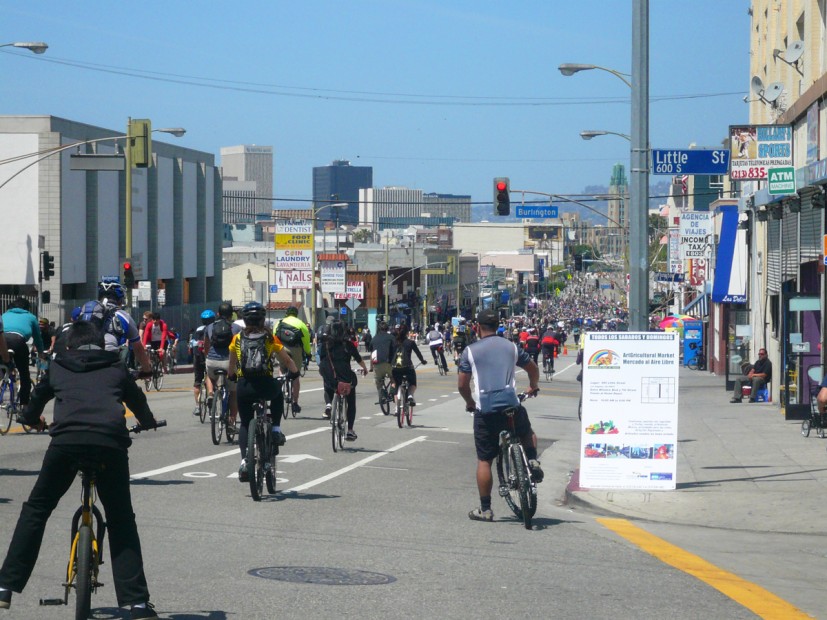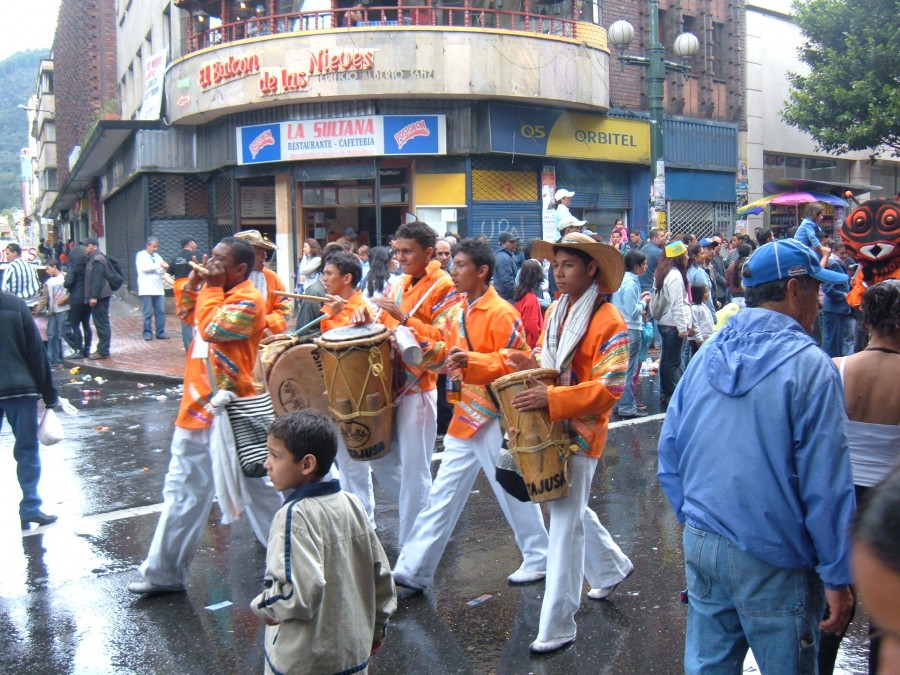Sustainabilities: Vernacular
Urban planning and development ideas circulate through regional, national, and international networks of experts, policymakers, and investors. But the same idea, plucked from abroad and cultivated by local hands in local soil, bears strange fruit. Los Angeles’ biggest walking and biking event, CicLAvia, started from a Colombian idea that circulated through a New York-based urbanist network, yet its success and its challenge are wholly Angeleno. The model closes streets to vehicular traffic for several hours on Sundays in order to provide a welcoming street space for biking and walking. It creates a linear park space of varying lengths, usually between seven and ten miles, that tens of thousands of people pass through during each event. As an early organizer of CicLAvia, I see it as a site for observing the multiple urbanisms that define Los Angeles’ public spaces and the shifting economic values attached to them. Making streets feel more welcoming has economic effects, in a property system like ours, and cultural celebrations can become mechanisms transforming community assets into private profit, but shining a light on LA’s diverse urban worlds projects a postcolonial message, if you know where to look.

CicLAvia in Downtown LA, 2012
CicLAvia is modeled after the ciclovía (roughly, “bike way” or “bike street”), an event that began in Bogotá, Colombia in the mid 1970s. Intended by its organizing group, PRO-CICLA, to increase public safety and promote less polluting transportation in the congested metropolis, the ciclovía closed streets to motorized traffic so that people could stroll and pedal through the city center on Sunday mornings. A June 1976 clipping from Bogotá’s El Tiempo newspaper describes it as moving the city “del carro a la bicicleta” (from the car to the bicycle). In the 1990s, the ciclovía took on a new life when an eccentric and populist mayor, Antanus Mockus, expanded the event as part of his playful approach to improving public culture in the city.1
Bogotá’s next mayor, Enrique Peñalosa, promoted the bicycle transportation aspect of the event, adding paved bike paths throughout the city. After leaving office, he became an international ambassador for Bogotá’s sustainable transportation innovations. As it has circulated internationally through planning and political networks, the ciclovía has taken on novel meanings.2 Since the late 2000s, active transportation and public health advocates and officials have organized “open streets“ events around the United States as a fun way to promote biking and walking. The bogotano emphasis on civic culture has been less central in the open streets movement, which has instead focused on population health outcomes as a measure of success.3

Ciclovía in Bogotá, 2008
LA’s story is a little different because our ciclovía began as a grassroots organizing effort rather than a city-initiated public health or transportation planning project. The organizing committee coalesced in September 2008, composed of both lifelong Angelenos and newcomers to the city. Some saw the idea as an opportunity to further their ongoing social change work in the region. For others, it was a chance to engage in new urban experiments. We worked for two years, gaining momentum through the alignment of political will and our appeal to LA’s diverse bicycling cultures.4 There have been at least two CicLAvia events each year since its first iteration on October 10, 2010, and it has shifted routes to connect new parts of the city through close collaboration with community-based organizations. The hybridization worked, to the surprise of many, and CicLAvia has been lauded as a transformative move forward for transportation in the region.5
However, something embedded in the event has thus far gone unrecognized: CicLAvia’s break with mainstream bicycle planning. The ciclovía made it to LA through international sustainable transportation knowledge networks, but it works in LA because of the shared public culture across a Latin American metropolis and a Latin@ one. In many ways, Los Angeles is a Latin American city, from its mestizo origins as a Spanish and then Mexican town, to the ongoing waves of migration that have brought inhabitants from Mexico and Central America and kept español audible. Dominant trends in bike planning tend to originate in Northern European countries; was it not more fitting to bring something Latin American to the streets of El Pueblo de Nuestra Señora la Reina de los Ángeles del Río de Porciúncula? An event rooted in a vernacular urbanism opens the door to recognizing that different worlds inhabit shared public spaces. It’s postcolonial by design.
When I spoke with Colombian PRO-CICLA organizer Jaime Ortíz Mariño in 2008, he agreed, emphasizing the disruption in flow represented by a transportation idea from South America taking hold in the United States. Colombia had borrowed U.S. highway designs, approximating modernity through automobile infrastructure, but now the U.S. was looking to Colombia for less destructive alternatives. Jaime sketched me a map of the world that showed what he called the “global center” (as opposed to “global south”) as the “unión de naciones asoleadas” (“Union of Sunlit Nations”). As Jaime put it, up in the U.S. we were the “provincianos,” and in sending a carfree event north, they were “universalizing” us.
CicLAvia’s postcolonial significance has largely been overlooked in interpretations of the event, and its current organizers tie the concept to the “tactical urbanism” trend developed in New York City. I have found that some Los Angeles community activists see CicLAvia as an event that only made it to communities of color through strategic organizing after the first event. They critique it as yet another “livable streets” investment serving only affluent and white communities. When the route expanded to East LA, some in the community called it an unwelcome agent of gentrification.
There is no doubt that CicLAvia can be a change agent. Opening the streets can open the city, bringing outsider attention to neighborhoods long viewed as dangerous and uninhabitable. And CicLAvia comes on a bicycle, currently the quintessential symbol of white, middle class-centered urbanism. I have written elsewhere about “bike-friendly” projects used as a gentrification strategy, including the praise CicLAvia has received from the downtown Los Angeles development community.6 Thus, in the absence of investments in affordable housing, new bike projects can be understood together with urban gardens and greening initiatives as drivers of environmental gentrification.
Of course, CicLAvia is more than this. In a nation still struggling to grow beyond the racial and social segregation that has held us back for so long—and unlike sustainability efforts that are primarily eco-oriented—CicLAvia also sheds light on the diversity already present in LA It may be seen as a form of popular or vernacular sustainability, showing how traditional approaches to mobility used by poor people around the world are part of a broader mobility solution in the face of climate change. And in this sense, it forces an important question: how can we value and seek to sustain the neighborhood character of diverse, transnational communities at the same time that we sustain green space and reduce CO2 emissions? What does it mean to improve our streets when our economic order is structured to increase individual, not community, wealth?
Even if CicLAvia’s Latin@ roots were recognized, it would not be a safeguard against gentrification. It may become the latest example of the co-optation of cultural forms by dominant knowledges, such as what Latin@ studies scholar Johana Londoño has explored in the case of Latino design becoming a trend in high-end, new urbanist planning.7 It may also be part of the “gentefication“ trend, in which upwardly mobile Chicanos and Latinos whose wealth now exceeds that of their families of origin move back home and their greater spending power contributes to the rising property costs. We inhabit a moment of tangled desire lines, when the American Dream of achieving the social isolation of suburban life is losing its cachet but becoming more affordable, when we are recognizing the value of our urban cultural enclaves but displacing the people that make them. Our biking, walking, and transit-friendly cities are again becoming the centers of wealth, and their outskirts the affordable housing option tied to jobs by long and resource-intensive commutes8. Riding a bicycle used to be a symbol of poverty; increasingly, it is a symbol of wealth. [See also Transit-oriented Development]
CicLAvia’s success lies in the fact that many people already traversed Los Angeles en bici. The bicycle itself is not novel, only its respectability. Bustling life in central LA is also nothing new, though we might homogenize it if we continue to recklessly value places separately from the people who make them interesting. In CicLAvia all this unfolds, because it is a site of experimental intersection between how we travel and where we live, eat, and play. These aspects of development and planning are regulated separately, often with contradictions in terms of who can afford to stay in our new, “sustainable” urban centers. But perhaps CicLAvia will shed light on the need for more holistic approaches, and the necessary relationships, for instance, between green and affordable housing and transit. We may yet join the Union of Sunlit Nations. Stubbornly, I am hopeful, though I know I can’t make all of LA see CicLAvia my way.
– Adonia Lugo
Published June 1, 2015
1. Arvind Singhal and Karen Greiner, “Performance Activism and Civic Engagement Through Symbolic and Playful Actions.” Journal of Development Communication, 19:2 (2008), 43–53.
2. Sergio Montero, “Worlding Bogotá's Ciclovía: From Urban Experiment to International ’Best Practice.’” Latin American Perspectives (forthcoming).
3. For example, see the “Open Streets Initiatives: Measuring Success” toolkit sponsored by a major public health funder, the Robert Wood Johnson Foundation.
4. I chronicled the origins of the event in Adonia E. Lugo, “CicLAvia and Human Infrastructure in Los Angeles: Ethnographic Experiments in Equitable Bike Planning.” Journal of Transport Geography, 30:2 (2013), 202–207.
5. Adam Nagourney, “Los Angeles Lives by Car, but Learns to Embrace Bikes.” New York Times, May 20, 2012.
6. Melody Lynn Hoffmann and Adonia E. Lugo, “Who Is ’World Class’? Transportation Justice and Bicycle Policy.” Urbanities, 4:1 (2014) 45–61.
7. Johana Londoño, “Latino Design in an Age of Neoliberal Multiculturalism: Contemporary Changes in Latin/o American Urban Cultural Representation.” Identities: Global Studies in Culture and Power, 17:5 (2014), 487–509.
8. Robert Suro, Jill H. Wilson, and Audrey Singer, “Immigration and Poverty in America’s Suburbs.” Washington, D.C.: Brookings Institution, 2011.
Visit Sites
- 16th & Mission
- Bateson State Office Building
- Bayview-Hunters Point
- Beach Flats Community Garden
- Cesar Chavez Street
- CicLAvia
- Ecotopia
- Fruitvale Transit Village
- Gonzales
- Googleplex
- Haight Ashbury Recycling Center
- Integral Urban House
- La Mesa Verde, San Jose
- Los Angeles Eco-Village
- Mandela MarketPlace
- North Berkeley Farmers’ Market
- Oakland Ecopolis
- Pajaro Valley Watershed
- Treasure Island
- West Oakland

